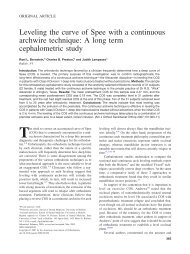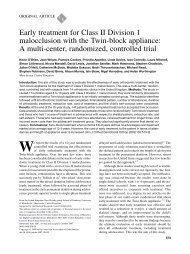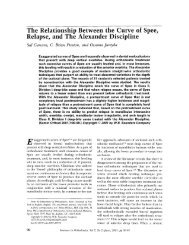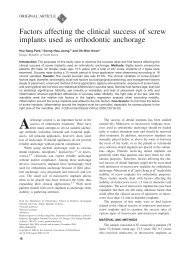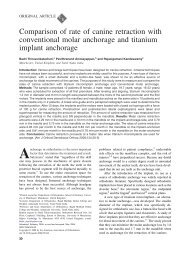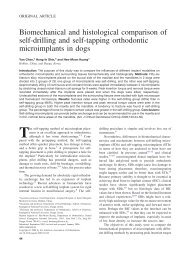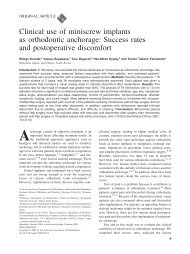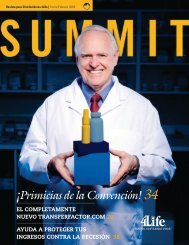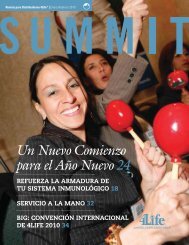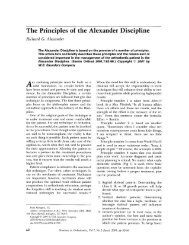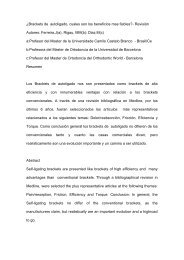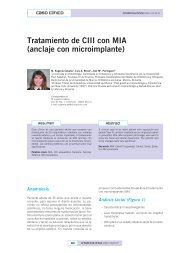Patients' expectations of orthodontic treatment - New York University
Patients' expectations of orthodontic treatment - New York University
Patients' expectations of orthodontic treatment - New York University
Create successful ePaper yourself
Turn your PDF publications into a flip-book with our unique Google optimized e-Paper software.
SCIENTIFIC<br />
SECTION<br />
Patients’ <strong>expectations</strong> <strong>of</strong> <strong>orthodontic</strong><br />
<strong>treatment</strong>: Part 2—findings from a<br />
questionnaire survey<br />
M. S. Sayers<br />
Orthodontic Department, Eastman Dental Institute, London, UK<br />
J. T. <strong>New</strong>ton<br />
Department <strong>of</strong> Oral Health Services & Dental Public Health, King’s College, London, UK<br />
Objective: To describe patients’ and their parents’ <strong>expectations</strong> <strong>of</strong> <strong>orthodontic</strong> <strong>treatment</strong>.<br />
Design: A questionnaire survey <strong>of</strong> 100 patients and their primary care-givers attending a new patient <strong>orthodontic</strong> consultant<br />
clinic, at a teaching hospital.<br />
Setting: GKT Orthodontic Department, King’s College Dental Hospital, London, UK.<br />
Subjects: The sample consisted <strong>of</strong> 100 participants who completed the questionnaire, including 50 patients aged 12–14 years<br />
who had been referred to the <strong>orthodontic</strong> department for <strong>treatment</strong>. One parent <strong>of</strong> each patient was also invited to participate.<br />
Materials and methods: Participants completed a valid questionnaire measure <strong>of</strong> <strong>orthodontic</strong> <strong>expectations</strong> that was tested for<br />
reliability and validity. Descriptive analysis <strong>of</strong> the responses was undertaken, and comparisons <strong>of</strong> children’s and parents’<br />
<strong>expectations</strong>, in addition to ethnicity, were made.<br />
Results: Patients and parents have similar <strong>expectations</strong> <strong>of</strong> <strong>treatment</strong>, with the exception <strong>of</strong> <strong>expectations</strong> <strong>of</strong> duration <strong>of</strong><br />
<strong>orthodontic</strong> <strong>treatment</strong> (P,0.01), having a brace fitted at the initial visit (P,0.05), and restrictions with regard to what one can<br />
eat and drink as a result <strong>of</strong> <strong>orthodontic</strong> <strong>treatment</strong> (P,0.05). Among the patient participants, different ethnic groups displayed<br />
different <strong>expectations</strong> <strong>of</strong> the initial <strong>orthodontic</strong> assessment visit, the likelihood <strong>of</strong> wearing headgear, the impact <strong>of</strong> <strong>orthodontic</strong><br />
<strong>treatment</strong> on diet, and the reaction <strong>of</strong> peers to <strong>treatment</strong> (P,0.05). For patients, ethnic group differences were reported for<br />
<strong>expectations</strong> regarding the initial visit, headgear and dietary restrictions (P,0.05).<br />
Conclusions: Patients and their parents share similar <strong>expectations</strong> <strong>of</strong> <strong>orthodontic</strong> <strong>treatment</strong> for most aspects <strong>of</strong> care, although<br />
parents are more realistic in their estimation <strong>of</strong> the duration <strong>of</strong> <strong>treatment</strong> and the initial visit. The <strong>expectations</strong> <strong>of</strong> patients<br />
differ from those <strong>of</strong> their parents with regard to dietary and drink restrictions in relation to <strong>orthodontic</strong> <strong>treatment</strong>. Ethnicity<br />
significantly influences <strong>expectations</strong> <strong>of</strong> <strong>orthodontic</strong> <strong>treatment</strong>, and this may relate to differences in the patients’ and their<br />
parents’ assessed outcome <strong>of</strong> care.<br />
Key words: Patient <strong>expectations</strong>, <strong>orthodontic</strong>s, questionnaire, measure<br />
Received 16th June 2005; accepted 20th July 2006<br />
Introduction<br />
There are few studies that have examined patients’<br />
<strong>expectations</strong> <strong>of</strong> <strong>orthodontic</strong> <strong>treatment</strong> in the UK.<br />
Studies have focused on parents’ <strong>expectations</strong> <strong>of</strong><br />
<strong>orthodontic</strong> <strong>treatment</strong>, and have not directly measured<br />
patients’ <strong>expectations</strong>. 1,2 The questionnaires used to<br />
measure patients’ and parents’ <strong>expectations</strong> require<br />
further psychometric validation (reliability and validity<br />
tests). 2,3 In one study, an adaptation <strong>of</strong> a questionnaire<br />
to measure patients’ <strong>expectations</strong> <strong>of</strong> orthognathic<br />
Journal <strong>of</strong> Orthodontics, Vol. 34, 2007, 25–35<br />
surgery was used to measure patients’ <strong>expectations</strong> <strong>of</strong><br />
<strong>orthodontic</strong> <strong>treatment</strong>. 4<br />
Other studies have measured patients’ and parents’<br />
<strong>expectations</strong> during <strong>orthodontic</strong> <strong>treatment</strong>, which introduces<br />
bias into the results. 3,4 Another study measured<br />
patients’ <strong>expectations</strong> <strong>of</strong> pain resulting from wearing<br />
fixed <strong>orthodontic</strong> appliances, while the general <strong>expectations</strong><br />
<strong>of</strong> <strong>orthodontic</strong> <strong>treatment</strong> were not investigated. 5<br />
There are few studies that have explored the<br />
relationship between <strong>orthodontic</strong> <strong>expectations</strong> and<br />
ethnicity. One author states that the social and cultural<br />
Address for correspondence: Mr M. Sayers, Orthodontic<br />
Department, Eastman Dental Institute, 257 Gray’s Inn Road,<br />
London WC1X 8LD, UK.<br />
Email: marksayers29@hotmail.com<br />
# 2007 British Orthodontic Society DOI 10.1179/146531207225021888
26 M. S. Sayers and J. T. <strong>New</strong>ton Scientific Section JO March 2007<br />
<strong>expectations</strong> with regard to dental appearance<br />
have changed with time in the USA. Social and<br />
cultural <strong>expectations</strong> and pressures produce a<br />
culturally valid need for <strong>orthodontic</strong> <strong>treatment</strong>, and<br />
social and cultural <strong>expectations</strong> condition peer and<br />
adult <strong>expectations</strong>. 6<br />
The <strong>orthodontic</strong> <strong>expectations</strong> <strong>of</strong> White Caucasians<br />
and Pakistani Muslim patients and their parents were<br />
investigated through semi-structured qualitative<br />
interviews. 7 The authors explored the relationship<br />
between culture, language and inappropriate <strong>orthodontic</strong><br />
<strong>expectations</strong>.<br />
The aim <strong>of</strong> this article is to report patients’ and their<br />
parents’ <strong>expectations</strong> <strong>of</strong> <strong>orthodontic</strong> <strong>treatment</strong> when<br />
measured using a questionnaire that was psychometrically<br />
validated, and the relationship <strong>of</strong> ethnicity<br />
to patients’ and parents’ <strong>expectations</strong> <strong>of</strong> <strong>orthodontic</strong><br />
<strong>treatment</strong>.<br />
Materials and methods<br />
Ethical approval was granted by King’s College<br />
Hospital Research Ethics Committee (LREC 02-123)<br />
and King’s College Research and Development<br />
Committee.<br />
A questionnaire was used to measure patients’ and<br />
their parents’ <strong>expectations</strong> <strong>of</strong> <strong>orthodontic</strong> <strong>treatment</strong> (see<br />
Appendix 1). A visual analogue scale (VAS) marked at<br />
10-mm intervals was used as the Likert response format<br />
for all questions except questions 8 and 9. Inclusion<br />
criteria for participation in the study were:<br />
N new patients and their parents presenting to the<br />
<strong>orthodontic</strong> consultant clinic;<br />
N patients aged 12–14 years;<br />
N patients with no previous history <strong>of</strong> <strong>orthodontic</strong><br />
<strong>treatment</strong>;<br />
N consent obtained from both the child and the parent.<br />
One hundred and seventy-four subjects were invited to<br />
participate in the study before attending their newpatient<br />
<strong>orthodontic</strong> consultation. They consisted <strong>of</strong> 87<br />
patients and their 87 parents. An information sheet was<br />
given to both the patient and parent before written<br />
consent was obtained from both the child and their<br />
parent. Patients completed their questionnaires separately<br />
from the accompanying parent.<br />
Comparisons <strong>of</strong> child and parent <strong>expectations</strong>, as well<br />
as <strong>expectations</strong> reported by different ethnic group, were<br />
made using statistical tests. However, no sample size<br />
calculations were made a priori, because this was a new<br />
questionnaire measure with no available data to make<br />
an estimate.<br />
Results<br />
Characteristics <strong>of</strong> the sample<br />
A total <strong>of</strong> 100 subjects completed the questionnaire<br />
during the period December 2002–April 2003. They<br />
consisted <strong>of</strong> 50 patient participants aged between 12 and<br />
14 years, and 50 <strong>of</strong> their parents (mean age 41 years).<br />
Sixty-three per cent <strong>of</strong> patient participants were female,<br />
and 68% <strong>of</strong> parent participants were female. The<br />
findings from the questionnaire were analysed using<br />
SPSS Version 10.0 (SPSS Corporation, Chicago, USA).<br />
Comparison <strong>of</strong> child and parent participants<br />
Responses from parent and child participants were<br />
compared. No statistically significant difference was<br />
seen between children’s and parents’ responses, except<br />
for questions 1a, 6 and 8 (Tables 1 and 2).<br />
Responses to question 1 revealed that children and<br />
their parents had low <strong>expectations</strong> with regard to an<br />
<strong>orthodontic</strong> appliance being fitted on the initial visit.<br />
However, parent participants had significantly lower<br />
<strong>expectations</strong> compared to child participants (P,0.05).<br />
Table 1 Comparison <strong>of</strong> parent and child data (n5100).<br />
Question Mean (adult) Mean (child) P,0.05<br />
1a 22.9 35.5 *<br />
1b 77.9 71.5 NS<br />
1c 83.0 77.7 NS<br />
1d 61.7 54.7 NS<br />
1e 50.0 47.5 NS<br />
1f 67.9 59.8 NS<br />
2a 58.1 61.5 NS<br />
2b 52.4 51.8 NS<br />
2c 44.6 45.0 NS<br />
2d 21.2 16.4 NS<br />
2e 24.0 19.4 NS<br />
3 37.9 36.5 NS<br />
4 44.0 43.8 NS<br />
5 47.3 52.5 NS<br />
6 47.5 58.1 *<br />
7 49.7 49.0 NS<br />
10a 80.9 76.5 NS<br />
10b 65.1 61.5 NS<br />
10c 45.6 41.3 NS<br />
10d 39.8 37.2 NS<br />
10e 54.2 49.9 NS<br />
10f 45.6 35.5 NS<br />
10g 67.8 55.5 NS<br />
*Statistical significance is set at P,0.05<br />
NS, not significant<br />
For details <strong>of</strong> questions, see Appendix 1
JO March 2007 Scientific Section Patients’ <strong>expectations</strong> <strong>of</strong> <strong>orthodontic</strong> <strong>treatment</strong> 27<br />
Responses to question 6 revealed that child participants<br />
had greater <strong>expectations</strong> <strong>of</strong> restrictions with regard to<br />
what they could eat or drink as a result <strong>of</strong> <strong>orthodontic</strong><br />
<strong>treatment</strong>, compared to parent participants (P,0.05).<br />
Question 8 showed statistically significant differences<br />
between child and parent participants’ responses<br />
(P,0.01). Table 2 shows that nearly 50% <strong>of</strong> child<br />
participants did not know how long <strong>orthodontic</strong><br />
<strong>treatment</strong> would take. Twice as many child participants<br />
as parents expected <strong>orthodontic</strong> <strong>treatment</strong> to be<br />
completed within 1 year (Table 2).<br />
Ethnicity<br />
Ethnic classification was carried out according the UK<br />
census guidelines. Sixty-three per cent <strong>of</strong> participants<br />
classified themselves as British, and 10% as Caribbean;<br />
the other categories had smaller numbers <strong>of</strong> participants<br />
(Table 3). In order to analyse the data, two larger groups<br />
were constructed by combining groups A, B and C (White<br />
British, White Irish and other White backgrounds) to<br />
form group 1, and the remaining groups to form group 2.<br />
Different responses were found between the two ethnic<br />
groups <strong>of</strong> child participants, and these were statistically<br />
significant (see Table 4). Expectations differed with<br />
regard to their initial visit, anticipation <strong>of</strong> headgear<br />
wear, pain associated with <strong>treatment</strong>, dietary restrictions,<br />
reaction <strong>of</strong> their peers to <strong>orthodontic</strong> <strong>treatment</strong>,<br />
and speech improvement.<br />
Table 2 Duration <strong>of</strong> <strong>orthodontic</strong> <strong>treatment</strong> (question 8).<br />
Duration <strong>of</strong> <strong>treatment</strong> Child participant (n550) Parent participant (n550) Total number <strong>of</strong> participants (n5100)<br />
,1 year 7 3 10<br />
1–1.5 years 7 15 22<br />
1.6–2 years 6 8 14<br />
.2–3 years 3 10 13<br />
.3 years 4 2 6<br />
Don’t know 23 12 35<br />
Chi-square test shows statistical significance (P,0.01)<br />
Table 3 Ethnic origin <strong>of</strong> participants (n5100).<br />
Ethnic origin<br />
A B C D J M N R<br />
British Irish Other White<br />
Table 4 Relationship between ethnic origin and child participants’<br />
responses (n550).<br />
Question Mean: ethnic group 1 Mean: ethnic group 2 P value<br />
1a 27.1 62.0 0.01*<br />
1b 77.9 49.6 0.01*<br />
1c 79.1 73.1 0.61<br />
1d 51.8 63.8 0.22<br />
1e 48.7 43.7 0.62<br />
1f 61.5 54.2 0.46<br />
2a 58.7 70.2 0.24<br />
2b 51.3 53.5 0.81<br />
2c 43.9 49.2 0.54<br />
2d 13.3 28.6 0.02*<br />
2e 15.2 34.0 0.29<br />
3 37.0 34.8 0.67<br />
4 37.9 62.5 0.02*<br />
5 50.7 58.3 0.46<br />
6 52.0 77.5 0.02*<br />
7 43.8 65.7 0.01*<br />
10a 73.4 86.0 0.09<br />
10b 59.0 68.8 0.31<br />
10c 38.7 49.3 0.34<br />
10d 31.5 54.8 0.03*<br />
10e 46.1 61.8 0.19<br />
10f 30.9 49.9 0.09<br />
10g 52.6 64.0 0.17<br />
*Statistical significance is set at P,0.05<br />
For details <strong>of</strong> questions, see Appendix 1<br />
White and Black<br />
Caribbean Pakistani Caribbean African Chinese<br />
Child participant 33 2 2 1 1 5 3 1 2<br />
Parent participant 30 4 2 1 5 5 1 2<br />
Total 63 6 4 1 2 10 8 2 4<br />
Not reported
28 M. S. Sayers and J. T. <strong>New</strong>ton Scientific Section JO March 2007<br />
The two ethnic groups <strong>of</strong> parent participants showed<br />
statistically significant differences in response with<br />
regard to their <strong>expectations</strong> <strong>of</strong> their child’s initial visit,<br />
headgear wear and dietary restrictions (see Table 5).<br />
Discussion<br />
Child and parent participants have similar <strong>expectations</strong><br />
<strong>of</strong> <strong>orthodontic</strong> <strong>treatment</strong>, as shown in a previous study. 3<br />
The majority <strong>of</strong> patients and parents had no expected<br />
experiences <strong>of</strong> <strong>orthodontic</strong> <strong>treatment</strong>. The expectation<br />
<strong>of</strong> an <strong>orthodontic</strong> appliance being fitted at the initial<br />
visit was significantly lower in parent participants than<br />
in children. However, <strong>expectations</strong> <strong>of</strong> pain, discomfort,<br />
problems with eating, speaking and cleaning teeth, and<br />
embarrassment with wearing fixed <strong>orthodontic</strong> appliances,<br />
were anticipated. Similar findings were reported<br />
by Bennett et al. 2<br />
Both child and parent participants revealed low<br />
<strong>expectations</strong> <strong>of</strong> <strong>orthodontic</strong> <strong>treatment</strong> involving headgear,<br />
surgery or dental extractions. This may be one<br />
reason for poor compliance with headgear wear. It is<br />
also interesting to see that participants leaned towards<br />
Table 5 Relationship between ethnic origin and parent participants’<br />
responses (n550).<br />
Question Mean: ethnic group 1 Mean: ethnic group 2 P value<br />
1a 17.1 38.1 0.05<br />
1b 81.0 69.5 0.02*<br />
1c 84.7 79.6 0.41<br />
1d 62.3 60.0 0.95<br />
1e 49.1 52.6 0.77<br />
1f 69.3 64.6 0.42<br />
2a 61.4 50.6 0.27<br />
2b 51.6 54.3 0.48<br />
2c 46.6 39.2 0.40<br />
2d 17.3 31.8 0.03*<br />
2e 19.2 37.0 0.06<br />
3 37.1 40.5 1.0<br />
4 43.3 45.7 0.74<br />
5 47.0 47.9 0.92<br />
6 40.5 65.0 0.002**<br />
7 45.6 60.5 0.08<br />
10a 79.3 85.5 0.17<br />
10b 61.4 74.3 0.14<br />
10c 41.2 56.7 0.09<br />
10d 36.5 48.0 0.18<br />
10e 48.6 68.4 0.06<br />
10f 44.1 49.7 0.55<br />
10g 68.1 66.9 0.63<br />
*Statistical significance is set at P,0.05<br />
**Statistical significance is set at P,0.01<br />
For details <strong>of</strong> questions, see Appendix 1<br />
non-extraction <strong>orthodontic</strong> <strong>treatment</strong>. Children and<br />
their parents did not expect pain and masticatory<br />
difficulties to be associated with <strong>orthodontic</strong> <strong>treatment</strong>.<br />
Firestone et al. 5 reported that participants underestimated<br />
the changes that they need to make in their diet as<br />
a result <strong>of</strong> pain associated with <strong>orthodontic</strong> <strong>treatment</strong>.<br />
Child participants expected significantly greater restrictions<br />
with regard to the types <strong>of</strong> food and drink that<br />
they could consume during <strong>orthodontic</strong> <strong>treatment</strong>, in<br />
comparison to parent participants. This may be because<br />
children are more aware <strong>of</strong> the need for a low-sugar and<br />
low-acid diet, as a result <strong>of</strong> talking to their peers who<br />
may have undergone <strong>orthodontic</strong> <strong>treatment</strong>.<br />
No negative reaction from the public was expected by<br />
child and parent participants with regard to the wearing<br />
<strong>of</strong> fixed <strong>orthodontic</strong> appliances. This probably reflects<br />
the normalization <strong>of</strong> <strong>orthodontic</strong> <strong>treatment</strong> in the<br />
Western world. 6<br />
Parents seemed to be more informed about the<br />
duration <strong>of</strong> <strong>orthodontic</strong> <strong>treatment</strong> than their children.<br />
As more children are wearing fixed <strong>orthodontic</strong> appliances,<br />
it would have been expected that this information<br />
would have been passed on in peer conversation. The<br />
duration <strong>of</strong> <strong>orthodontic</strong> <strong>treatment</strong> has been shown to be<br />
poorly understood in some ethnic minorities. 7<br />
Patients and their parents have high <strong>expectations</strong> that<br />
<strong>orthodontic</strong> <strong>treatment</strong> will produce straight teeth and a<br />
better smile. However, <strong>expectations</strong> are higher with<br />
regard to straight teeth compared to a better smile.<br />
Parents expected a higher increase in social confidence<br />
as a result <strong>of</strong> <strong>orthodontic</strong> <strong>treatment</strong> than their children,<br />
as shown by Tung and Kiyak. 4<br />
Participants felt that <strong>orthodontic</strong> <strong>treatment</strong> was<br />
unlikely to improve mastication, speaking or career<br />
prospects. Shaw et al. 3 stated that patients and parents<br />
expected <strong>orthodontic</strong> <strong>treatment</strong> to improve mastication,<br />
speech, and success in future occupations.<br />
Responses from the child participants revealed significant<br />
differences between the two ethnic groups.<br />
Non-White participants had greater <strong>expectations</strong> <strong>of</strong><br />
<strong>orthodontic</strong> braces being fitted at their initial visit than<br />
White participants. Participants who identified themselves<br />
as White had greater <strong>expectations</strong> <strong>of</strong> a check-up<br />
and diagnosis and more realistic <strong>expectations</strong> <strong>of</strong> their<br />
initial visit than non-White participants.<br />
With regard to <strong>orthodontic</strong> <strong>treatment</strong>, there were<br />
greater <strong>expectations</strong> <strong>of</strong> having to wear headgear in the<br />
non-White group than among White participants. It<br />
seemed that <strong>expectations</strong> <strong>of</strong> <strong>orthodontic</strong> <strong>treatment</strong> were<br />
more negative in the non-White group because they<br />
anticipated more pain and dietary restrictions than<br />
White participants.
JO March 2007 Scientific Section Patients’ <strong>expectations</strong> <strong>of</strong> <strong>orthodontic</strong> <strong>treatment</strong> 29<br />
Children who indicated that their ethnicity was non-<br />
White expected a more positive reaction from people<br />
with regard to their fixed <strong>orthodontic</strong> appliances. This<br />
reflects the different social–cultural <strong>expectations</strong> with<br />
regard to perfectly occluding teeth and a beautiful<br />
dentition. 6<br />
Differences in the benefits <strong>of</strong> <strong>orthodontic</strong> <strong>treatment</strong><br />
were seen between the two child ethnic groups, as non-<br />
White children expected greater speech improvements.<br />
This may be because these children anticipated greater<br />
functional benefits <strong>of</strong> <strong>orthodontic</strong> <strong>treatment</strong>.<br />
Parents who identified their ethnicity as White had a<br />
more realistic anticipation <strong>of</strong> their child’s initial visit,<br />
because they expected the first visit to be a check-up and<br />
diagnosis. This may be because they were better<br />
informed. Khan and Williams 7 showed that there were<br />
expectation differences between White Caucasians and<br />
Pakistani Muslims with regard to <strong>orthodontic</strong> <strong>treatment</strong>.<br />
The authors state that Pakistani parents failed to<br />
understand what was involved and the duration <strong>of</strong><br />
<strong>orthodontic</strong> <strong>treatment</strong>; this was largely due to language<br />
and cultural barriers.<br />
Non-White parents expected headgear wear and more<br />
dietary and drink restrictions. White parents may not<br />
have anticipated changes to their child’s diet in the same<br />
way, because they viewed <strong>orthodontic</strong> <strong>treatment</strong> as a<br />
normal, unrestrictive procedure. 6 This seems to be in<br />
disagreement with the study that showed that Pakistani<br />
parents failed to understand the dietary requirements<br />
involved in <strong>orthodontic</strong> <strong>treatment</strong>. 7<br />
Weaknesses <strong>of</strong> the study<br />
The sample size limited full differentiation between all<br />
ethnic groups. Therefore, the groups were combined<br />
into two larger groups for analysis. Group 1 consisted <strong>of</strong><br />
the White ethnic groups, and group 2 consisted <strong>of</strong> the<br />
other ethnic groups; this was similar to the method used<br />
by Tung and Kiyak. 4 However, a larger sample size is<br />
required to analyse the effect that ethnicity has on<br />
<strong>orthodontic</strong> <strong>expectations</strong> for each ethnic group.<br />
The effect <strong>of</strong> occupation on parents’ <strong>expectations</strong> <strong>of</strong><br />
<strong>orthodontic</strong> <strong>treatment</strong> could not be analysed, because<br />
the sample size limited full differentiation into occupational<br />
groups. However, studies have shown that<br />
pr<strong>of</strong>essional parents anticipate that straight teeth will<br />
aid future occupational success, 3 and educated fathers<br />
and parents with higher incomes have increased<br />
<strong>expectations</strong> <strong>of</strong> the benefits <strong>of</strong> <strong>orthodontic</strong> <strong>treatment</strong>. 2<br />
A larger sample is needed to explore the relationship<br />
between parents’ occupation and their <strong>expectations</strong> with<br />
regard to <strong>orthodontic</strong> <strong>treatment</strong>.<br />
The results from the questionnaire are threatened by<br />
biases and errors. 8 Biases could have resulted from<br />
mood bias (people in low spirits may underestimate their<br />
health status), non-response bias (patients not completing<br />
all the questions), and response style bias (participants<br />
responding to questions in the same manner<br />
regardless <strong>of</strong> the question). Random measurement error<br />
could occur when a respondent guesses or gives an<br />
unpredictable response. Selection bias is included, as<br />
only 12 to 14-year-old patients were investigated.<br />
Uninformed or equivocal <strong>expectations</strong> shown by<br />
patients and their parents may reflect a person’s inability<br />
or unwillingness to communicate their <strong>expectations</strong>. 9<br />
This could represent social desirability bias, which leads<br />
to a response set where participants wish to give a<br />
preferred image. 9<br />
Strengths <strong>of</strong> the study<br />
Patients’ and their parents’ <strong>expectations</strong> <strong>of</strong> <strong>orthodontic</strong><br />
<strong>treatment</strong> were measured using a psychometrically<br />
validated questionnaire based on a UK population,<br />
and not a modified questionnaire. 8<br />
Information was collected before the pre-<strong>treatment</strong><br />
consultation, which reduced bias in responses. Other<br />
authorities have stated that orthodontists should ask<br />
patients about their <strong>expectations</strong> before <strong>treatment</strong>. 10<br />
The study collected data on patients’ and their<br />
parents’ <strong>expectations</strong> <strong>of</strong> their initial visit, type <strong>of</strong><br />
<strong>treatment</strong> expected, problems associated with <strong>orthodontic</strong><br />
<strong>treatment</strong>, duration and frequency <strong>of</strong> attendance,<br />
and the expected benefits <strong>of</strong> <strong>treatment</strong>.<br />
The relationship between ethnicity and patients’ and<br />
their parents’ <strong>expectations</strong> was examined. This has not<br />
been widely explored in the published literature.<br />
Clinical practice<br />
The questionnaire could be used to assess unrealistic<br />
<strong>expectations</strong> and aid the consent and <strong>treatment</strong>-planning<br />
process. As a result <strong>of</strong> understanding patients’<br />
anticipations, this measure may be used to reduce failed<br />
appointments, avoid premature termination <strong>of</strong> <strong>treatment</strong>,<br />
and increase patient compliance. These factors<br />
help to improve the quality <strong>of</strong> <strong>orthodontic</strong> <strong>treatment</strong><br />
provided to the patient.<br />
Conclusions<br />
Information collected from 12 to 14-year-old patients<br />
and their parents with regard to <strong>orthodontic</strong> <strong>expectations</strong><br />
reveals the following:<br />
N Patients and their parents have similar <strong>expectations</strong>.
30 M. S. Sayers and J. T. <strong>New</strong>ton Scientific Section JO March 2007<br />
N Significant differences in <strong>orthodontic</strong> <strong>expectations</strong><br />
were seen between patients and their parents with<br />
regard to their initial visit, and dietary and drinking<br />
restrictions, in addition to duration <strong>of</strong> <strong>treatment</strong>.<br />
Parents had lower <strong>expectations</strong> <strong>of</strong> <strong>orthodontic</strong> appliances<br />
being fitted at their child’s initial appointment<br />
than child participants (P,0.05). Children had<br />
greater <strong>expectations</strong> <strong>of</strong> dietary and drinking restrictions<br />
in relation to <strong>orthodontic</strong> <strong>treatment</strong> than parent<br />
participants (P,0.05). Parents had a more realistic<br />
expectation <strong>of</strong> the duration <strong>of</strong> <strong>orthodontic</strong> <strong>treatment</strong><br />
(P,0.01).<br />
N Ethnicity significantly influences children’s and<br />
parents’ <strong>expectations</strong> <strong>of</strong> <strong>orthodontic</strong> <strong>treatment</strong><br />
(P,0.05). The extent <strong>of</strong> its influence requires further<br />
investigation.<br />
Contributors<br />
Mark Sayers was responsible for the recruitment <strong>of</strong><br />
the participants, data collection, content analysis,<br />
designing the questionnaire and drafting the article.<br />
Tim <strong>New</strong>ton was responsible for study design, content<br />
analysis, statistical data analysis, critical revision, expert<br />
advice and final approval <strong>of</strong> the article. Pr<strong>of</strong>essor<br />
Fraser McDonald helped in critical appraisal and<br />
advice. In addition, Liz O’Higgins, Shruti Patel and<br />
Mr Powell allowed access to recruitment <strong>of</strong> patients<br />
referred to their consultant clinics. Tim <strong>New</strong>ton is the<br />
guarantor.<br />
References<br />
1. Becker A, Shapira J, Chaushu S. Orthodontic <strong>treatment</strong> for<br />
disabled children: motivation, expectation, and satisfaction.<br />
Eur J Orthod 2000; 22: 151–58.<br />
2. Bennett EM, Michaels C, O’Brien K, Weyant R, Phillips C,<br />
Vig KD. Measuring beliefs about <strong>orthodontic</strong> <strong>treatment</strong>: a<br />
questionnaire approach. J Public Health Dent 1997; 57: 215–23.<br />
3. Shaw WC, Gabe MJ, Jones BM. The <strong>expectations</strong> <strong>of</strong><br />
<strong>orthodontic</strong> patients in South Wales and St Louis,<br />
Missouri. Br J Orthod 1979; 6: 203–5.<br />
4. Tung AW, Kiyak AH. Psychological influences on the<br />
timing <strong>of</strong> <strong>orthodontic</strong> <strong>treatment</strong>. Am J Orthod Dent<strong>of</strong>acial<br />
Orthop 1998; 113: 29–39.<br />
5. Firestone AR, Scheurer PA, Burgen B. Patients’ anticipation<br />
<strong>of</strong> pain and pain-related side effects and their<br />
perception <strong>of</strong> pain as a result <strong>of</strong> <strong>orthodontic</strong> <strong>treatment</strong><br />
with fixed appliances. Eur J Orthod 1999; 21: 387–96.<br />
6. Jenny J. A social perspective on need and demand for<br />
<strong>orthodontic</strong> <strong>treatment</strong>. Int Dent J 1975; 25: 248–56.<br />
7. Khan FA, Williams S. Cultural barriers to successful<br />
communication during <strong>orthodontic</strong> care. Community Dent<br />
Health 1999; 16: 256–61.<br />
8. Bowling A. Research Methods in Health—Investigating<br />
Health and Health Services, 2nd Edn. Buckingham: Open<br />
<strong>University</strong> Press, 2002.<br />
9. Thompson AG, Sunol R. Expectations as determinants <strong>of</strong><br />
patient satisfaction: concepts, theory and evidence. Int J<br />
Qual Health Care 1995; 7: 127–41.<br />
10. Bos A, Hoogstraten J, Prahl-Andersen B. Expectations <strong>of</strong><br />
<strong>treatment</strong> and satisfaction with dent<strong>of</strong>acial appearance in<br />
<strong>orthodontic</strong> patients. Am J Orthod Dent<strong>of</strong>acial Orthop 2003;<br />
123: 127–32.
JO March 2007 Scientific Section Patients’ <strong>expectations</strong> <strong>of</strong> <strong>orthodontic</strong> <strong>treatment</strong> 31<br />
Appendix 1
32 M. S. Sayers and J. T. <strong>New</strong>ton Scientific Section JO March 2007
JO March 2007 Scientific Section Patients’ <strong>expectations</strong> <strong>of</strong> <strong>orthodontic</strong> <strong>treatment</strong> 33
34 M. S. Sayers and J. T. <strong>New</strong>ton Scientific Section JO March 2007
JO March 2007 Scientific Section Patients’ <strong>expectations</strong> <strong>of</strong> <strong>orthodontic</strong> <strong>treatment</strong> 35



